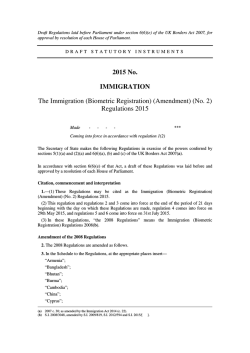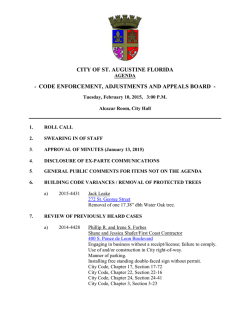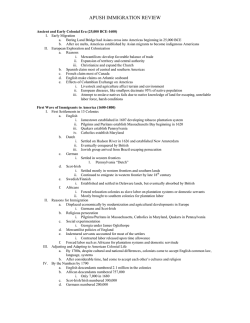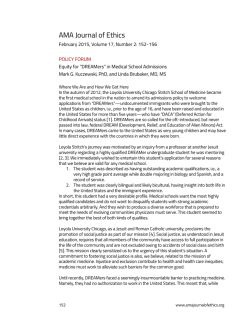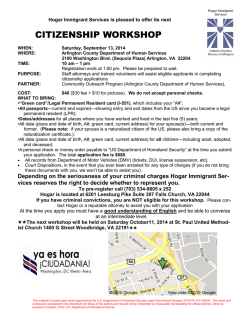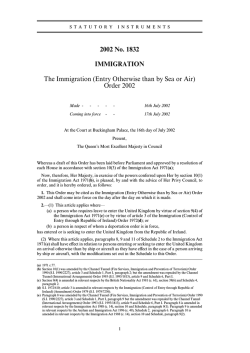
Part 3: POL[ICE] IN MY HEAD - Undocumented and Uninsured
Photo: Adrian Gonzalez UNDOCUMENTED AND UNINSURED A Five-Part Report on Immigrant Youth and the Struggle to Access Health Care in California PMS 646 (100%) PART 3: POL[ICE] IN MY HEAD A REPORT BY THE DREAM RESOURCE CENTER OF THE UCLA LABOR CENTER PMS 646 (60%) PMS 108 ( POL[ICE] IN MY HEAD Undocumented youth live with exclusion from health services and fear of deportation, both of which cause and aggravate trauma. Policies such as the Priority Enforcement Program (PEPComm) and 287G contribute to high numbers of deportations and increase immigrant communities’ mistrust of government authorities. The police and Immigration and Customs Enforcement (ICE) are not only in immigrant neighborhoods but also in the minds of undocumented people, triggering constant anticipation of harm and hypervigilant behavior.1 Emerging research indicates that immigrant youth experience feelings of shame, anger, despair, marginalization, and uncertainty stemming from discrimination, anti-immigrant sentiment, xenophobia, fear of deportation, and institutional barriers.2 Daily legal and economic uncertainties elevate the risk of anxiety, depression, and vulnerability to mental illness for immigrant youth.3 Emotional traumas manifest in poor physical and mental health, which often goes untreated. For mixed-status families where household members have different immigration statuses, those who have insurance can access health care while undocumented family members are denied access.4 I am afraid if I go out, I will be deported. A VIRUS OF FEAR The immigration and criminal justice systems in the United States have become increasingly integrated over the past thirty years through shared databases and partnerships between local law enforcement and federal agencies.5 This joint system of policing streamlines deportations, even for individuals with minor offenses. As a result of policies such as PEP-Comm and 287G, local law enforcement takes on traditional federal responsibilities, such as checking immigration documents. Although immigration violations are civil offenses, many are processed as criminal acts.6 These policies, along with over 2 million deportations by the Obama administration, have spread a virus of fear and mistrust throughout immigrant communities in the United States. Anti-immigrant sentiment and excessive surveillance establish fear as central to the immigrant experience. Immigrants expect to be monitored by authorities and constantly worry that any misstep could lead to deportation and family separation. Seemingly mundane situations such as driving, working, or even walking down the street cause undocumented people anxiety and discourage them from accessing services that are vital to their health and safety. Bad experiences with the police, institutional barriers, xenophobia, and racist encounters can cause trauma and emotional distress for immigrants. Many undocumented people struggle with depression, anxiety, and stress over their status, which interferes with everyday activities and leads to feelings of hopelessness. For others, the fear of deportation is so great they avoid leaving their homes altogether. A participant shared, “I am afraid if I go out, I will be deported.” The restriction of ordinary activities, such as going to the store, to school, or to the doctor’s office, leads to loneliness and isolation. For the undocumented, mental health issues are stigmatized and in many cases go unaddressed, indirectly normalizing pain, suffering, and fear. These mental health strains manifest in physical ailments. For example, constant vigilance leads to sleep deprivation and physical illness. With limited access to both mental and physical health resources, undocumented communities have had to find ways to cope. BECOMING THE POL[ICE] Immigrant youth internalize surveillance, engaging in self-monitoring as a tool for self-preservation. The goal of self-monitoring is to ensure conformity to social norms.7 One participant shared, “I always try to be a law-abiding citizen so I don’t get deported.” Another participant stated that she felt the need to always “be cautious. [I] don’t put myself in situations that might get me arrested.” Among the immigrant youth surveyed, 83 percent self-monitor to some degree. This internalized surveillance can cause stress and anxiety, as immigrant youth must be ever vigilant to stay under the radar. One participant shared “I am conscious of every step that I take.” Another stated, “The constant fear has become part of the experience.” Monitoring behavior is crucial for survival and overall wellness. Because exposure to law enforcement can lead to the disclosure of status and potential deportation, avoiding law enforcement, especially while driving, is the main way participants self-monitor. One participant shared, “Whenever I am in public places, I check if there’s any police, especially if I am away from my parents. I imagine what would happen if they were to come up to us, like ICE and stuff.” Many participants stated that they are “always careful when driving and always watch for cops.” Even for recipients of Deferred Action for Childhood Arrivals (DACA), the practice of self-monitoring has not disappeared.8 For some, the pressure to be a “model citizen” and avoid law enforcement continues: “Having received DACA, [I] feel I have to do everything right so it doesn’t get revoked. [I] don’t drink too much. There is discrimination by the police who make everything a big deal. [I] make sure to act right.” Another DACA participant shared, “Even though I have my license, I still have fear and monitor my driving.” Immigrant youth continue to be impacted by the trauma they experienced while undocumented--fear that goes beyond immigration status. Undocumented youth also avoid circumstances that can lead to injury or the need to access health services. As one participant shared, My family has gotten used to not seeking help, even in severe conditions. I see other people with insurmountable debt because of health related issues, and I get scared that the same will happen to me. Self-monitoring can be a method of preventative care necessitated by limited access to a steady income, health care, or insurance. Some participants expressed that they are careful with their diets and exercise daily to try to maintain good health and avoid the need for health care. Since access to the dentist is also very limited, many participants take extra steps to maintain good dental health as well. Undocumented youth have developed survival mechanisms. Self-monitoring has become second nature. It is common for undocumented youth to create rigid schedules to avoid situations that could result in danger, deportation, or unexpected expenses. The need to constantly monitor their behavior becomes a habit and eventually impacts their mental and emotional wellness. TABLE 1: Mental and Emotional Health Access Immigrant Youth Survey Data Report self-monitoring Have access to counseling services Have access to emotional wellness services Participate in support groups Percentage 83% 27% 30% 19% *Source: Healthy California Survey 2014 Photo: Pocho-One Fotography RESILIENCE IS NOT ENOUGH Self-monitoring and fear have become so integral a part of the immigrant experience that undocumented youth view their anxiety, depression, and grief as normal. It is common for people, particularly undocumented people, to dismiss mental and emotional wellness. Research shows that nearly half of all individuals experiencing mental turmoil, such as depression, have delayed seeking care for an average of eight years.9 For immigrants, the waiting period may be much longer. As one participant shared, “Since I don’t have health care, I’ve dealt with depression, and it’s been hard trying to find help like therapy or counseling.” It is critical that health care experts provide services and resources that promote the socio-emotional and psychological well being of undocumented people. Only about a fourth of immigrant youth surveyed (27 percent) have access to counseling services, and less than one-third (30 percent) have access to emotional wellness services. Although immigrant youth have expressed an urgent need for mental health support, only 19 percent shared that they have sought out support groups, such as talking circles, as a source of care. Recent research shows that sociocultural, structural, and procedural barriers all play a significant role in the underutilization of mental health services.10 Sociocultural barriers, such as stigma about mental illness, greatly influence whether people will seek mental health services. In many communities, there is a great deal of shame when discussing mental health.11 For most of the undocumented youth surveyed in this study, accessing mental health resources is perceived as something done by “crazy” or unstable people. When asked if they sought out mental health services, participants often responded by stating, “I’m not crazy,” suggesting that they would have to suffer from severe mental illness before they would seek support. Structural barriers also play a major role in the accessibility of mental health resources. Even with the desire to access mental health services, the fear that they would have to disclose their status deters undocumented youth. One participant shared, “For those undocumented, [there] is a big fear of being asked for your social security number. A lot of undocumented families don’t go. There is always a fear, they’re going to ask for this and that, they are going to put you on the spot… because you don’t have a SSN to show. We are always in the shadows, even with health.” Clinical and procedural barriers further deter immigrant youth from accessing mental health care. Even when mental health services are accessible, they are rarely effective for immigrant communities. Services often lack cultural sensitivity or relevance to immigrants and make them feel uncomfortable.12 As one participant shared, “People are not so much aware of the hardships and trauma it causes and don’t really know how to help even if they want to. A course on how to work with undocumented people would be awesome!” There is a need for services that validate the experiences and real-life challenges of immigrant communities. Photo: Sam Comen Photography I just wish there were more help, mental and emotional help for undocumented people. It’s hard to find it if it’s not through a university but even then, it’s limited. CONCLUSION AND RECOMMENDATIONS The need for healing within immigrant communities is pervasive. To ensure the well-being of immigrant youth, we must address the criminalization and policing of undocumented communities and provide accessible social and emotional support services. LOCAL AND STATE POLICY RECOMMENDATIONS MENTAL HEALTH POLICY RECOMMENDATIONS ✦ Restore trust of immigrant communities and government systems by eliminating the collaboration of local and federal agencies in immigration enforcement at the county, state and federal level. Examples include the dismissal of: ✦ Develop school-based resources that support the mental and emotional well-being of undocumented immigrant children. Federal and state programs 287G and Priority Enforcement Program Communities (PEP-Comm). l ICE contracts in Los Angeles, Orange County and San Diego. l Notification of release practices of undocumented detainees from local law enforcement to ICE and Customs and Border Protection. l ✦ Establish law enforcement accountability practices through: Developing civilian oversight commissions. l Establishing Attorney General measures to investigate and prosecute acts of violence on behalf of law enforcement. l Appointing a special prosecutor in the Attorney General’s office to investigate and pursue criminal cases against law enforcement that engage in violent use of force in communities and detention centers. l ✦ Establish a process under the Attorney General’s Office for Certification of U-Visas for undocumented victims of crime, including law enforcement perpetrators. ✦ Incorporate mental health services in advocacy efforts for the remaining uninsured. ✦ Develop an anti-stigma campaign to address emotional wellness for immigrant populations. HEALTH SERVICE PROVIDER RECOMMENDATIONS ✦ Provide in-service trainings for professional service providers on how to work with immigrant undocumented populations. ✦ Identify key staff members to develop resources and services for immigrant patients. ✦ Develop and implement a referral process by legal aid programs and counseling services. ✦ Include members of the undocumented community in the development of programs and services for undocumented immigrant patients. METHODOLOGY This report presents the results of the first statewide survey about immigrant youth, led by immigrant youth. We asked participants a series of standardized questions about their experience accessing health care in California. We surveyed 550 undocumented and “DACAmented” (recipients of Deferred Action for Childhood Arrivals) Californians between the ages of 18 and 32, using a participatory methodology that allowed those directly excluded from health care access to lead the research process. A team comprised of 37 immigrant youth conducted face-to-face surveys with their peers during summer 2013. The data and analysis in the report reflects the experiences and real-life barriers to health care faced by undocumented people. STUDY DEMOGRAPHICS 41% REGION Los Angeles Northern California Orange County 55% 93% Latina/o Hispanic 36% 18–21 yrs old 44% Male 3% Asian San Diego 8% 2% Mixed Race 7% Inland Empire Central Valley 3% Undocumented 22–26 yrs old Female 10% 42% Deferred Action for Childhood Arrival Recipient 47% AGE RACE 10% 55% IMMIGRATION STATUS GENDER 24% Other 17% 27–32 yrs old <1% Genderqueer, Transgender and Other <2% Pacific Islander, White, Native American and Other 1 Asian Americans Advancing Justice, “PEP-Comm & the Trust Act: A Brief Guide to What You Need to Know,” December 2014, http://www.catrustact.org/uploads/2/5/4/6/25464410/aaaj-alc_-_pep_and_trust_act_fact_sheet_-_dec_2014.pdf. The Priority Enforcement Program, or PEP-Comm, is a Department of Homeland Security (DHS) program that replaced the Secure Communities program after Obama’s 2014 executive action. The program is designed to identify immigrants in US jails who are deportable. Participating jails submit arrestees’ fingerprints to not only criminal but also immigration databases. Individuals who are deportable receive a notification but are not requested for detention as they were under Secure Communities. U.S. Immigration and Customs Enforcement, “Delegation of Immigration Authority Section 287(g) Immigration and Nationality Act,” http://www.ice.gov/287g/. This program allows state and local law enforcement entities to enter into a partnership with ICE, delegating authority to them for immigration enforcement within their jurisdictions. 2 William Perez and Richard Douglas Cortes, Undocumented Latino College Students: Their Socioemotional and Academic Experiences (Dallas, TX: LFB Scholarly Publishing, 2011). 3 Manny J. González and Gladys González-Ramos, Mental Health Care for New Hispanic Immigrants: Innovative Approaches in Contemporary Clinical Practice (New York: Haworth, 2005). 4 Jeffrey S. Passel and D’Vera Cohn, “Unauthorized Immigrant Population: National and State Trends, 2010,” Pew Research Center, February 1, 2011, http://www.pewhispanic.org/files/reports/133.pdf. 5 Juliet P. Stumpf, “The Crimmigration Crisis: Immigrants, Crime, and Sovereign Power.” American University Law Review no. 56(2006): 367-420. 6 Jennifer M. Chacón, “Overcriminalizing Immigration,” Journal of Criminal Law and Criminology 102, no. 3 (2012): 613–652, http://scholarlycommons.law.northwestern.edu/jclc/vol102/iss3/5; David Alan Sklansky, “Crime, Immigration, and Ad Hoc Instrumentalism,” New Criminal Law Review 15, no. 2 (2012): 157–223, doi: 10.1525/nclr.2012.15.2.157. 7 Steven W. Gangestad and Mark Snyder, “Self-Monitoring: Appraisal and Reappraisal,” Psychological Bulletin 126, no. 4 (2000): 530–555, http://www.communicationcache.com/uploads/1/0/8/8/10887248/self-monitoring-_appraisal_and_reappraisal.pdf. 8 U.S. Citizenship and Immigration Services, “Consideration of Deferred Action for Childhood Arrivals (DACA),” http://www. uscis.gov/humanitarian/consideration-deferred-action-childhood-arrivals-daca. Deferred Action for Childhood Arrivals (DACA) is a use of prosecutorial discretion to defer removal action against certain individuals who came to the United States as children and meet several guidelines. DACA recipients are eligible for work authorization valid for a period of two years. Deferred action does not provide legal status. 9 P. S. Wang et al, “Failure and Delay in Initial Treatment Contact after First Onset of Mental Disorders in the National Comorbidity Survey Replication,” Archives of General Psychiatry 62 no. 6 (2005): 603–613, doi: 10.1001/archpsyc.62.6.603. 10 American Psychological Association, “Crossroads: The Psychology of Immigration in the New Century,” APA Presidential Task Force on Immigration, 2012, http://www.apa.org/topics/immigration/immigration-report.pdf. 11 B. A. Kitchener, A. J. Jorm, and C. M. Kelly, “Mental Health First Aid USA,” Maryland Department of Health and Mental Hygiene, Missouri Department of Mental Health, and National Council for Community Behavioral Healthcare, 2009. 12Kenneth I. Maton et al, “Minority Students of Color and the Psychology Graduate Pipeline: Disquieting and Encouraging Trends, 1989–2003,” American Psychologist 61 no. 2 (2006): 117–131, doi: 10. 1037/0003-066X.61.2.117. This research was made possible by The California Endowment. Thank you for your continued support to advance the health of immigrant communities. Report Authors Imelda S. Plascencia Alma Leyva Mayra Yoana Jaimes Pena Saba Waheed Community Contributors Lilian Saldana, Coordinator, CIRCLE Project; Jonathan Perez, Statewide Coordinator, Immigrant Youth Coalition Research Team Adriana Aguilar Esthela Aguilar* Jewell Alingasa Yesenia Ayala Cristhian Barrera Nayelli Casarrubias David Castro Mayra Contreras Hairo Cortes Nidia De Leon Amanda Em Marco Flores* Perla Flores* Angelica Hernandez Dalia Hernandez Mayra Yoana Jaimes Pena** Adrian James Carlos Juarez Alma Leyva** Janeth Lopez Miguel Montalva Lizeth Montiel Malin Ouk Ma Denise Panaligan Imelda S. Plascencia** Luis Ramirez Cesar Resendiz Giovanni Rodriguez Maria Rodriguez Nadia Rojas Seleny Rodriguez Angelica Tellez Hernandez* Crisly Ulloa Alex Vazquez Jose Vazquez Xiomara Ramos Villasenor Elizabeth Zambrano **Project Coordinator *Regional Intern Coordinator Advisory Board Leisy Abrego, Ph.D. UCLA, Department of Chicana/o Studies Alejandro Covarrubias INSPIRE / UCLA, Department of Chicana/o Studies Roberto Gonzalez Harvard Graduate School of Education Alvaro Huerta National Immigration Law Center Sandra Martinez The California Wellness Foundation Virginia Mosqueda The California Endowment Nadareh Pourat UCLA Center for Health Policy Research Patricia Rizo Community Health Promoter Fabiola Santiago Human Impact Partners Ena Valladares California Latinas for Reproductive Justice Nancy Zuniga Instituto de Educacion Popular del Sur de California (IDEPSCA) Labor Center Team Ana Muñiz, Director, Dream Resource Center Saba Waheed, Research Director Stefanie Ritoper, Communications Director Julie Monroe, Project Director Delia Esmeralda Arriaga, Project Manager Janna Shadduck-Hernandez, Project Director
© Copyright 2025
